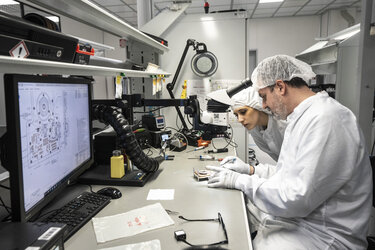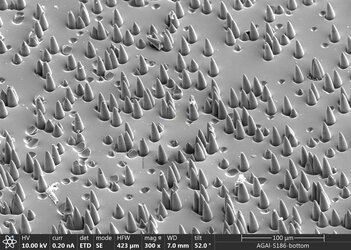Accept all cookies Accept only essential cookies See our Cookie Notice

About ESA
The European Space Agency (ESA) is Europe’s gateway to space. Its mission is to shape the development of Europe’s space capability and ensure that investment in space continues to deliver benefits to the citizens of Europe and the world.
Highlights
ESA - United space in Europe
This is ESA ESA facts Member States & Cooperating States Funding Director General Top management For Member State Delegations European vision European Space Policy ESA & EU Responsibility & Sustainability Annual Report Calendar of meetings Corporate newsEstablishments & sites
ESA Headquarters ESA ESTEC ESA ESOC ESA ESRIN ESA EAC ESA ESAC Europe's Spaceport ESA ESEC ESA ECSAT Brussels Office Washington OfficeWorking with ESA
Business with ESA ESA Commercialisation Gateway Law at ESA Careers Cyber resilience at ESA IT at ESA Newsroom Partnerships Merchandising Licence Education Open Space Innovation Platform Integrity and Reporting Administrative Tribunal Health and SafetyMore about ESA
History ESA Historical Archives Exhibitions Publications Art & Culture ESA Merchandise Kids Diversity ESA Brand Centre ESA ChampionsSpace in Member States
Find out more about space activities in our 23 Member States, and understand how ESA works together with their national agencies, institutions and organisations.
Science & Exploration
Exploring our Solar System and unlocking the secrets of the Universe
Go to topicAstronauts
Missions
Juice Euclid Webb Solar Orbiter BepiColombo Gaia ExoMars Cheops Exoplanet missions More missionsActivities
International Space Station Orion service module Gateway Concordia Caves & Pangaea BenefitsSpace Safety
Protecting life and infrastructure on Earth and in orbit
Go to topicAsteroids
Asteroids and Planetary Defence Asteroid danger explained Flyeye telescope: asteroid detection Hera mission: asteroid deflection Near-Earth Object Coordination CentreSpace junk
About space debris Space debris by the numbers Space Environment Report In space refuelling, refurbishing and removingSafety from space
Clean Space ecodesign Zero Debris Technologies Space for Earth Supporting Sustainable DevelopmentLatest
Applications
Using space to benefit citizens and meet future challenges on Earth
Go to topicObserving the Earth
Observing the Earth Future EO Copernicus Meteorology Space for our climate Satellite missionsCommercialisation
ESA Commercialisation Gateway Open Space Innovation Platform Business Incubation ESA Space SolutionsLatest
Enabling & Support
Making space accessible and developing the technologies for the future
Go to topicBuilding missions
Space Engineering and Technology Test centre Laboratories Concurrent Design Facility Preparing for the future Shaping the Future Discovery and Preparation Advanced Concepts TeamSpace transportation
Space Transportation Ariane Vega Space Rider Future space transportation Boost! Europe's Spaceport Launches from Europe's Spaceport from 2012Latest
Galileo, the best Atomic Clock in space
Thank you for liking
You have already liked this page, you can only like it once!
Galileo - the atomic clock
ESA TV Exchanges
GIOVE B will be launched from Baikonur on 27 April. Time - is at the heart of the Galileo system. This second Galileo satellite is therefore equipped with the most accurate clock ever to be flown in space. The graphic explanation shows how the atomic clock works.
For more info on this subject please check the script that is online as a PDF file under :http://television.esa.int/photos/EbS56666.pdf
A WMV preview clip (english version) is online under : http://esa.contentcoders.com/mphi/atomic_TV_en_19-04-08_wmphigh.wmv
The french version under :http://esa.contentcoders.com/mphi/atomic_TV_fr_19-04-08_wmphigh.wmv
More backgroud information can be found on: http://www.giove.esa.int/
10:00:00:00 ESA intro
10:00:30:00 Galileo, the best atomic clock in space
10:00:40:00 Animation: earth and the Galileo constellation
""Although from a distance the Galileo constellation may look like a molecule with electron satellites and the earth as its core, this atomic comparison only really comes into its own when one considers what lies at the heart of Galileo: the measurement of time! In fact the Galileo system is one vast space clock the accuracy of which is crucial to the quality of position calculations and to ensure the success of this, Europe has developed what are known as atomic clocks. An atomic clock that deviates by one nano second produces an error on the ground of 30 centimetres, which, if translated to a second, makes an error of 300,000 kilometres ñ which means one might as well be on the moon!! Hence the importance of reducing inaccuracy and the key role played by the clocks on board the Galileo satellites.
Animation: inside the sa
-
CREDIT
ESA -
LICENCE
ESA Standard Licence
-
Documentary
-
-

Atomic clock development

Galileo: how does it work?

Galileo infographic:'Timekeeping to a few billionths…

Galileo infographic 'Clocks on the shady side'















 Germany
Germany
 Austria
Austria
 Belgium
Belgium
 Denmark
Denmark
 Spain
Spain
 Estonia
Estonia
 Finland
Finland
 France
France
 Greece
Greece
 Hungary
Hungary
 Ireland
Ireland
 Italy
Italy
 Luxembourg
Luxembourg
 Norway
Norway
 The Netherlands
The Netherlands
 Poland
Poland
 Portugal
Portugal
 Czechia
Czechia
 Romania
Romania
 United Kingdom
United Kingdom
 Slovenia
Slovenia
 Sweden
Sweden
 Switzerland
Switzerland

























